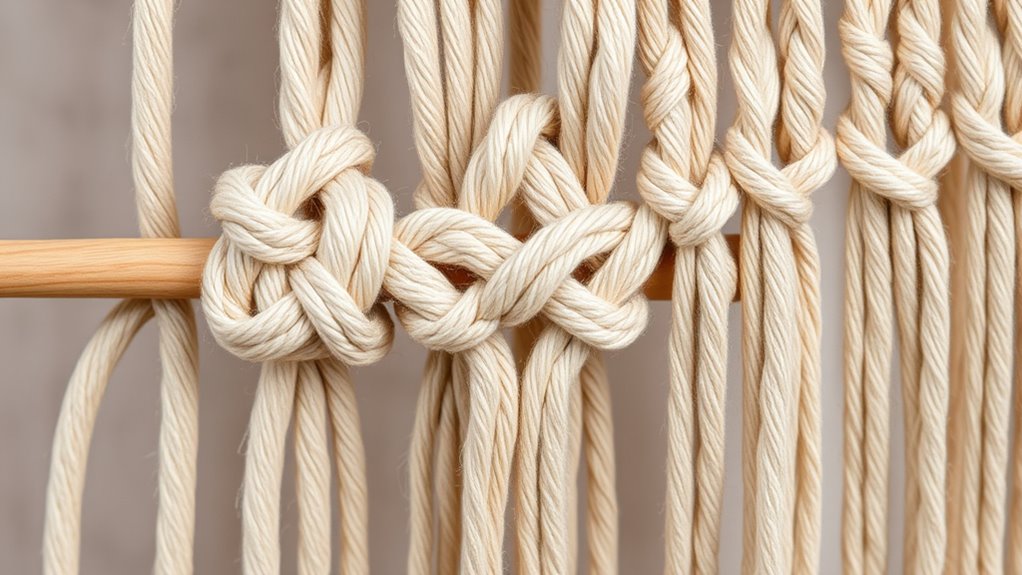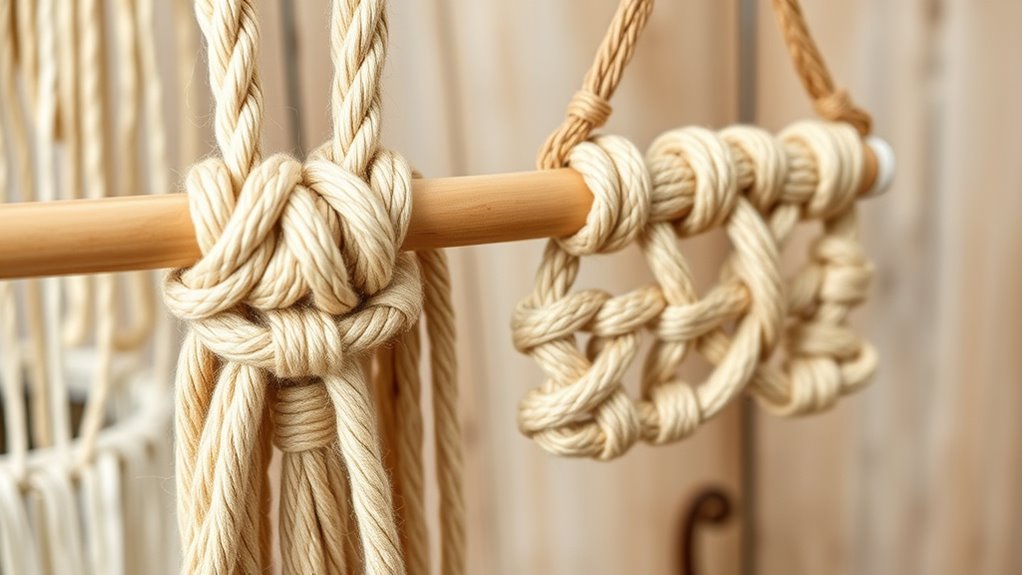To master basic macramé knots, focus on the Lark’s Head, Square, and Half-Hitch. The Lark’s Head is perfect for attaching cords to a support and gives your project a clean look. The Square Knot adds balance and decorative detail, while the Half-Hitch allows you to create curves and borders. Together, these knots form the foundation for many patterns and textures. Keep exploring, and you’ll discover how these knots open up endless creative possibilities.
Key Takeaways
- The Lark’s Head knot is fundamental for attaching cords to supports, creating a neat and symmetrical base.
- The Square knot offers a secure, balanced pattern often used for borders and decorative accents.
- The Half-Hitch knot is ideal for forming curves, angles, and adding texture to designs.
- Mastering these knots allows for complex, customizable macramé patterns and project stability.
- Combining these knots unlocks endless creative possibilities in macramé designs.

Ever wondered how intricate knots can transform simple cords into stunning decorative pieces? The answer lies in mastering essential knotting techniques that form the foundation of macramé. These techniques allow you to craft decorative accents that add personality and charm to your home or accessories. The three fundamental knots—Lark’s Head, Square, and Half-Hitch—are the building blocks for countless designs. Once you get comfortable with these knots, you’ll find endless possibilities to create unique patterns and textures.
Master the three key knots—Lark’s Head, Square, and Half-Hitch—to unlock endless macramé design possibilities.
The Lark’s Head knot is perhaps the most basic yet versatile knot in your macramé toolkit. It’s perfect for attaching cords to a dowel or ring, creating a sturdy base for your work. To make this knot, fold a cord in half, then place the loop over your dowel or ring. Pull the loose ends through the loop and tighten. This knot not only secures your cords but also offers a clean, symmetrical look that works well for hanging planters or wall hangings. Its simplicity makes it an ideal starting point for beginners, and it’s essential for establishing your project’s structure.
Next, the Square knot is a staple in creating decorative accents. It’s a symmetrical knot that gives a neat, balanced appearance. To tie a square knot, you start by crossing the left cord over the right, then pulling it under and through to form a half knot. Repeat this process starting with the right cord over the left. The result is a tight, square-shaped knot that holds securely. You can use square knots to form patterns, borders, or intricate designs. Their versatility allows you to craft everything from jewelry to complex wall hangings, adding texture and visual interest to your work.
The Half-Hitch knot is equally essential, especially when forming curved or angled designs. It’s a quick, effective way to secure cords in a specific direction. To tie a half-hitch, wrap the working cord around a post or another cord, then pull the end through the loop. Repeating this knot along the same line creates a row of evenly spaced decorative accents. This technique is particularly useful for creating fringes, borders, or geometric shapes. When combined with other knots, the half-hitch enhances the overall design, giving your projects a polished, professional look.
Frequently Asked Questions
Can I Combine Different Macramé Knots in One Project?
Yes, you can definitely combine different macramé knots in one project. Using knot combination techniques, you can create unique textures and design elements, making your piece more interesting. Experiment with creative knot patterns by mixing knots like Lark’s Head, Square, and Half-Hitch. This approach adds variety and depth to your work, allowing you to personalize your project and develop your skills in knot artistry.
What Types of Cords Are Best for Macramé?
If you want your macramé masterpiece to resemble a tangled spaghetti nightmare, use thin, stretchy cords. For a more professional look, opt for natural fiber types like jute, cotton, or hemp, which hold knots well. Cord thickness matters too; thicker cords give your piece a bold, sturdy feel, while thinner ones create delicate designs. Choose wisely, or prepare for a project that fights back!
How Do I Fix a Knot That’s Too Tight?
To fix a knot that’s too tight, gently loosen it by carefully adjusting the tension. You can do this by slipping a thin tool, like a knitting needle or a toothpick, underneath the knot to loosen the tension and allow for easier reworking. This knot loosening helps you regain control, so you can adjust the tension to your desired tightness. Always work slowly to avoid damaging your cords.
Are There Variations of These Basic Knots?
Think of knotting as a canvas for your creativity—yes, there are variations of these basic knots! You can tweak the tension, combine different knots, or add twists to explore creative knotting. Knot variations like double half-hitches or alternating square knots open new artistic possibilities. Don’t be afraid to experiment; each variation adds a unique touch, transforming simple knots into stunning, personalized pieces.
How Do I Finish and Secure My Macramé Piece?
To finish and secure your macramé piece, you should use finishing techniques like gathering the ends and tying a secure knot, such as a square knot or double half-hitch, to prevent unraveling. You can also add a drop of fabric glue for extra security. Trim excess cords neatly, and consider using a decorative bead or wrap for a polished look. These anchoring methods ensure your project stays intact and looks professional.
Conclusion
Now that you’ve mastered the mighty lark’s head, splendid square, and helpful half-hitch knots, you’re ready to craft captivating creations. With your newfound knot knowledge, you can confidently continue creating, customizing, and decorating with dazzle. Embark on design details, develop your skills, and delight in the delightful dance of dexterous knotting. Keep experimenting, keep exploring, and let your macramé magic make your space stunning and your spirit soar!









